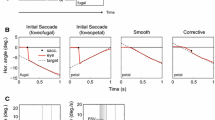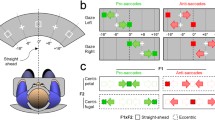Abstract
To examine the effects of smooth-pursuit eye movements on the initiation of saccades, their latency was measured when subjects initially fixated or pursued a target. In half of the block of trials, the fixation or pursuit target was extinguished 200 ms before the saccade target was illuminated (gap trials). Reduction of the mean saccade latency in the gap trials (the “gap effect”) was evident even when the subjects were pursuing a moving target, consistent with previous observations. The effect of pursuit direction on saccade latency was also examined. Saccades in the same direction as the preceding pursuit (forward saccades) had shorter latencies than those in the opposite direction (backward saccades). This asymmetry was observed in both the gap and nongap trials. Although the forward-backward asymmetry was much smaller than the “gap effect”, it was statistically significant in six of eight cases. These results suggest that the preparation of saccades is affected by smooth-pursuit eye movements.
Similar content being viewed by others
Author information
Authors and Affiliations
Additional information
Received: 2 June 1997 / Accepted: 6 November 1997
Rights and permissions
About this article
Cite this article
Tanaka, M., Yoshida, T. & Fukushima, K. Latency of saccades during smooth-pursuit eye movement in man Directional asymmetries. Exp Brain Res 121, 92–98 (1998). https://doi.org/10.1007/s002210050440
Issue Date:
DOI: https://doi.org/10.1007/s002210050440




